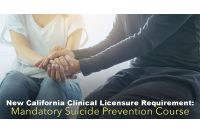

The state of California has always required its clinical practitioners to complete continuing education (CE) requirements in order to maintain their license. Soon, the state will require an additional CE class from new and active clinicians. Beginning on January 1, 2020 for California psychologists and January 1, 2021 for other licensed clinicians, such as MFTs, LCSWs, and LPCs, clinicians must complete six hours of suicide risk assessment and intervention training.
Signed into law in 2017 by former Governor Jerry Brown, the new training mandate is being implemented in response to rising suicide rates. With more individuals at risk than ever in California communities, it’s important that clinicians receive standardized training on assessing suicide risk and intervening when clients need support.
The new rule applies to current licensed practitioners as well as new graduates and pre-licensed professionals. Those applying to receive their license after January 1, 2020 (psychologists) or January 1, 2021 (all other clinical licenses) will need to demonstrate they completed this new requirement before taking the licensure exam. Currently licensed clinicians will need to declare they’ve met the requirement when renewing their license. All applicants need to retain proof of meeting the requirement, as the board might ask them to show documentation.
In order to support clinicians in meeting this requirement, the respective boards will offer a few different ways to meet the new suicide risk and intervention coursework. The three options are: meeting the requirement through a qualifying graduate program, meeting the requirement through applied clinical experience, and by taking an approved continuing education course.
Some clinicians can meet the new requirement through coursework offered at their qualifying graduate program. These applicants must demonstrate that their coursework met the same standard is a CE course on suicide assessment and intervention. They provide proof of completion through receiving a written statement from their graduate program certifying the student met the requirement through essential or supplement coursework.
Other applicants will or have already received the equivalent training on the job, in a setting such as clinical supervision, an internship, or practicum after graduation. In this instance, the applicant or licensed clinician will need to get a written statement from the clinical supervisor of their clinical practical experience, certifying that they completed this training in the workplace.
Applicants who don’t obtain the hours in their graduate program or practicum can do so in an approved continuing education course. You’ll need to take the course with a provider your board has approved. After completing the course, you will receive a certification, which you’ll need to keep as proof of meeting the requirement.
Clinicians can take the coursework to meet the requirement at any time before their licensure application or renewal is due, so encourage everyone to get started on meeting the requirement now. In some cases, clinicians will have already met the requirement in their graduate program or internship, in which case they’ll need to obtain proof from their school or suspervisor before the deadline.
For clinicians who plan to meet the new requirement through a CE course, AATBS is working on developing a course that will meet the requirement for all California clinicians. We are a well-established provider with a long-term, proven track record of creating quality online CE courses that meet licensure requirements. Stay up to date on the AATBS course progress by contacting us or visiting our website.
CE Course of the Month
Get started with a Mental Health Continuing Education Course for $1
View this $1 Course


